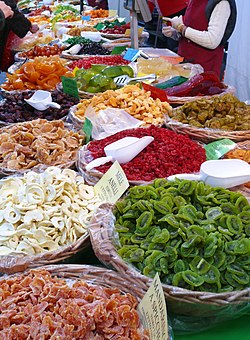This article's lead section contains information that is not included elsewhere in the article. (February 2023) |
 | |
| Alternative names | glacé fruit |
|---|---|
| Type | Confectionery |
| Main ingredients | Fruit or peel, syrup |


Candied fruit, also known as glacé fruit, is whole fruit, smaller pieces of fruit, or pieces of peel, placed in heated sugar syrup, which absorbs the moisture from within the fruit and eventually preserves it. Depending on the size and type of fruit, this process of preservation can take from several days to several months.[1] This process allows the fruit to remain edible for up to a year.[2] It has existed since the 14th century.[1]
The continual process of drenching the fruit in syrup causes the fruit to become saturated with sugar, preventing the growth of spoilage microorganisms due to resulting osmotic pressure.[3]
Fruits which are commonly candied include cherries, pineapple, greengages, pears, peaches and melon, as well as ginger root.[4] The principal candied peels are orange and citron; these, together with candied lemon peel, are the usual ingredients of mixed chopped peel. Candied vegetables are also made, from vegetables such as pumpkin, turnip and carrot.[5]
Though recipes vary, the general principle is to boil, then steep fruit in increasingly stronger sugar solutions for a number of weeks, then dry off any remaining water.[6]
- ^ a b "Food, Facts, and Trivia — Candied Fruit". Archived from the original on January 11, 2018. Retrieved November 22, 2007.
- ^ "LA Times - Proper Storage Keeps Candied Fruit Fresh". Los Angeles Times. April 6, 1989. Archived from the original on April 19, 2016. Retrieved April 4, 2016.
- ^ "Britannica Online Encyclopedia — Candied Fruit". Archived from the original on November 10, 2007. Retrieved November 23, 2007.
- ^ Answers.com (from The Food Lover's Companion) — candied fruit; candied flowers, with candied cherries being popularly referred to as "glacé cherries". Archived on November 24, 2009.
- ^ "How to distinguish quality candied fruits". December 27, 2018. Archived from the original on December 28, 2022. Retrieved December 29, 2022.
- ^ Beckett-Young, Kathleen (December 24, 1989). "FARE OF THE COUNTRY; Candied Fruit of Provence: Sweet Tradition". The New York Times. Archived from the original on July 28, 2018. Retrieved April 28, 2010.